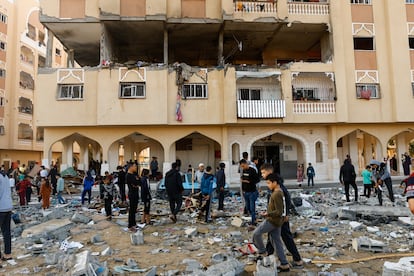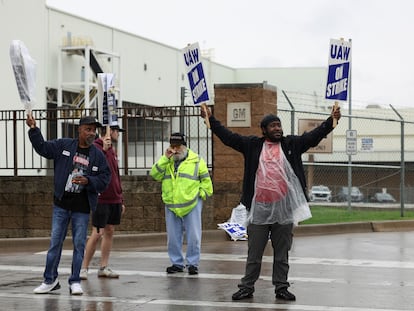Al Shifa Hospital patients, staff and displaced leave the compound as Israel strikes targets in south
Israeli forces have signaled they could expand their offensive toward Gaza’s south while continuing operations in the north

Patients, staff and displaced people left Gaza’s largest hospital Saturday, health officials said, leaving behind only a skeleton crew to care for those too sick to move and Israeli forces who had taken over the facility earlier in the week.
The exodus from Al Shifa Hospital in Gaza City came the same day internet and phone service was restored to the Gaza Strip, ending a telecommunications blackout that forced the United Nations to shut down critical humanitarian aid deliveries because it was unable to coordinate its convoys.
In the south, an Israeli airstrike hit a residential building on the outskirts of the town of Khan Younis, killing at least 26 Palestinians, according to a doctor at the hospital where the bodies were taken.
Israel’s military has been searching Al Shifa Hospital for traces of a Hamas command center that it alleges was located under the building — a claim Hamas and the hospital staff deny — and urging the several thousand people still there to leave.
On Saturday, the military said it had been asked by the hospital’s director to help those who would like to leave do so by a secure route.
The military said it did not order any evacuation, and that medical personnel are being allowed to remain in the hospital to support patients who cannot be moved.
But Medhat Abbas, a spokesman for the Health Ministry in Hamas-controlled Gaza, said the military had ordered the facility cleared, giving the hospital an hour to get people out.
Later, Dr. Ahmed Mokhallalati, a Shifa physician, said on social media that there were some 120 patients remaining who were unable to leave, including some in intensive care and premature babies, and that he and five other doctors were staying behind to care for them.
Israel has signaled plans to expand its offensive south while continuing operations in the north. In Khan Younis, the attack early Saturday hit Hamad City, a middle-class housing development built in recent years with funding from Qatar. In addition to the 26 people killed, another 20 were wounded, said Dr. Nehad Taeima at Nasser Hospital.
Israel rarely comments on individual strikes, saying only that it is targeting Hamas and trying to avoid harm to civilians. In many of the Israeli strikes, women and children have been among the dead.
The war, now in its seventh week, was triggered by Hamas’ Oct. 7 attack in southern Israel, in which militants killed about 1,200 people, mostly civilians, and abducted some 240 men, women and children.
More than 11,400 Palestinians have been killed in the war, two-thirds of them women and minors, according to Palestinian health authorities. Another 2,700 have been reported missing, believed buried under rubble. The count does not differentiate between civilians and combatants, and Israel says it has killed thousands of militants.
The U.N. has warned that Gaza’s 2.3 million people are running critically short of food and water, but it was not immediately clear when the agency for Palestinian refugees, known as UNRWA, would be able to resume the delivery of aid that was put on hold Friday.
The Palestinian telecommunications provider said it was able to restart its generators after UNRWA donated fuel. The end of the communications blackout meant a return to news and messages from journalists and activists in the besieged enclave on social media platforms as service began to return late Friday night.
Aid dries up
After an American request, Israel agreed to let a “very minimal” amount of fuel into Gaza each day, national security adviser Tzachi Hanegbi said. COGAT, the Israeli military body responsible for Palestinian affairs, said it would amount to 60,000 liters (15,850 gallons) a day for the U.N.
For the communications network, Israel also agreed on another 10,000 liters a day (2,640 gallons), a U.S. State Department official said.
UNRWA and other humanitarian groups need at least 120,000 liters (31,700 gallons) a day to run lifesaving functions, Touma said.
Gaza has received only 10% of its required food supplies each day in shipments from Egypt, according to the U.N., and the water system shutdown has left most of the population drinking contaminated water, causing an outbreak of disease.
Dehydration and malnutrition are growing, with nearly all residents in need of food, said Abeer Etefa, a Mideast regional spokeswoman for the U.N.’s World Food Program.
“People are facing the immediate possibility of starvation,” she said Thursday from Cairo.
March for hostages
Israeli officials previously vowed fuel would not be let in until Gaza militants release the hostages. The government has been under heavy public pressure to show it is doing all it can to bring back people abducted in Hamas’ attack.
Thousands of marchers — including families of over 50 hostages — embarked Friday on the fourth leg of a five-day walk from Tel Aviv to Jerusalem, chanting, “Bring them home!” They are marching to Prime Minister Benjamin Netanyahu’s office, calling on his war Cabinet to do more to rescue their loved ones. They have urged the cabinet to consider a cease-fire or prisoner swap in return for the hostages.
Hamas has offered to exchange all hostages for some 6,000 Palestinians in Israeli jails, which the Cabinet has rejected.
Conditions at Al Shifa
With Israeli troops fanned out around the Al Shifa hospital complex, doctors spoke of horrifying conditions inside. Electricity has been out for nearly a week, leaving incubators for infants and ventilators for ICU patients defunct. Nearly 7,000 people are trapped there with little food, including patients, staff and civilian families.
Hospital Director Mohammed Abu Selmia told Al Jazeera television that 52 patients have died since fuel ran out — up from 40 reported before Israeli troops stormed in on Wednesday. He said staff were amputating limbs of some patients to avoid infection spreading because of shortages in medicines.
More were on the verge of death as their wounds are “open with maggots coming out of them,” another doctor, Faisal Siyam, told Al Jazeera.
Dr. Ahmad Mukhalalti said most of the 36 premature infants suffer from severe diarrhea because there is no clean water. He said Israeli troops had taken away all the bodies from the morgue and from a mass grave that staff dug days earlier in the courtyard. The Israeli military had no comment on the report. The doctors’ accounts could not be independently verified.
Abu Selmia said Israeli troops should either bring them fuel to power equipment or allow an evacuation.
“The hospital has become a giant prison,” he said. “We are surrounded by death.”
Israel’s military said it delivered 4,000 liters of water and 1,500 ready-made meals to Shifa, but staff said it was too little for the numbers of people there.
Israeli military spokesman Col. Richard Hecht acknowledged that the troops’ search for traces of Hamas was going slowly. “It’s going to take time,” he said.
Israel faces pressure to prove its claim that Hamas set up its main command center in and under the hospital. So far, Israel has shown photos and video of weapons caches that it says were found inside as well as what it said was a tunnel entrance. The AP could not independently verify the Israeli claims.
The allegations are part of Israel’s broader accusation that Hamas uses Palestinians as human shields across the Gaza Strip, contending that is the reason for the large numbers of civilian casualties during weeks of bombardment.
Strikes in the south
Airstrikes continued to hammer the southern sector of Gaza, where most of the territory’s population is now sheltering. Among them are hundreds of thousands of people who heeded Israel’s calls to evacuate Gaza City and the north to get out of the way of its ground offensive.
In the Nusseirat refugee camp, a strike crushed a building to rubble killing at least 41 people, staff at the nearby hospital said. Residents said dozens more were buried in the wreckage.
Early morning strikes outside the city of Khan Younis killed 11 members of a family that evacuated from Gaza City. Dozens of wounded, including babies and young children, streamed into the nearby hospital.
At the morgue, Alaa Abu Hasira wept over the bodies from the strike that were lined up side by side on the floor, including her son, daughter and several sisters. “All my loved ones are gone,” she sobbed.
So far, Israel’s ground assault has focused on northern Gaza as it vows to remove Hamas from power and crush its military capabilities. If the assault moves into the south, it is not clear where Palestinians can go. Egypt has refused to allow a mass transfer onto its soil.
As the war continues to inflame tensions elsewhere, Israeli troops clashed with Palestinian gunmen in Jenin in the occupied West Bank, killing at least three Palestinians. The fighting broke out late Thursday during an Israeli raid.
Israel’s military said five militants were killed. The Palestinian Health Ministry said three people died. The militant Islamic Jihad group claimed the three dead as members and identified one as a local commander.
Sign up for our weekly newsletter to get more English-language news coverage from EL PAÍS USA Edition
Tu suscripción se está usando en otro dispositivo
¿Quieres añadir otro usuario a tu suscripción?
Si continúas leyendo en este dispositivo, no se podrá leer en el otro.
FlechaTu suscripción se está usando en otro dispositivo y solo puedes acceder a EL PAÍS desde un dispositivo a la vez.
Si quieres compartir tu cuenta, cambia tu suscripción a la modalidad Premium, así podrás añadir otro usuario. Cada uno accederá con su propia cuenta de email, lo que os permitirá personalizar vuestra experiencia en EL PAÍS.
¿Tienes una suscripción de empresa? Accede aquí para contratar más cuentas.
En el caso de no saber quién está usando tu cuenta, te recomendamos cambiar tu contraseña aquí.
Si decides continuar compartiendo tu cuenta, este mensaje se mostrará en tu dispositivo y en el de la otra persona que está usando tu cuenta de forma indefinida, afectando a tu experiencia de lectura. Puedes consultar aquí los términos y condiciones de la suscripción digital.
More information
Archived In
Últimas noticias
Welcome to the post-religion era: The idea of Christianity as the absolute truth has become obsolete
‘I thought you would like it’: The risky sexual practice popularized by TV shows and TikTok
The digitalization of tourism: ‘They promise experiences and gave us the worst possible one’
Mexican peso defies uncertainty with forecasts of a new period of stability in 2026
Most viewed
- Sinaloa Cartel war is taking its toll on Los Chapitos
- Oona Chaplin: ‘I told James Cameron that I was living in a treehouse and starting a permaculture project with a friend’
- Reinhard Genzel, Nobel laureate in physics: ‘One-minute videos will never give you the truth’
- Why the price of coffee has skyrocketed: from Brazilian plantations to specialty coffee houses
- Silver prices are going crazy: This is what’s fueling the rally










































